Computational Investigation of Montelukast and Its Structural Derivatives for Binding Affinity to Dopaminergic and Serotonergic Receptors: Insights from a Comprehensive Molecular Simulation
Abstract
1. Introduction
2. Results
2.1. Modification Strategy and Similarity Analysis
2.2. Molecular Docking Results, Binding Pose, and Binding Affinity Analysis
2.3. Molecular Dynamics (MD) Simulations: Structural Stability and Interaction Evaluation
2.4. Pharmacophore Modeling and In Silico ADMET Evaluation
3. Discussion
3.1. Main Findings and Structure-Activity Relationship Insights of Montelukast Derivatives
3.2. Limitations and Future Works
4. Materials and Methods
4.1. Three-Dimensional Structure Modifications and MM2 Energy Minimization
4.2. Three-Dimensional Structure Alignment and Similarity Analysis
4.3. Molecular Docking Simulations and Binding Affinity Analysis
4.4. Molecular Dynamics (MD) Simulation for Structural Stability and Interaction Analysis
4.5. Molecular Mechanics/Poisson–Boltzmann Surface Area (MM/PBSA) Calculations
- ΔG_binding represents the free energy associated with complex formation.
- ΔG_complex is the total free energy of the solvated ligand–receptor complex.
- ΔG_ligand corresponds to the free energy of the unbound ligand in solution.
- ΔG_receptor denotes the free energy of the solvated unbound receptor.
4.6. Pharmacophore Modeling and In Silico ADMET Evaluation
5. Conclusions
Supplementary Materials
Author Contributions
Funding
Institutional Review Board Statement
Informed Consent Statement
Data Availability Statement
Conflicts of Interest
Abbreviations
| 5-HT1A | Serotonin 1A receptor |
| ADMET | Absorption, distribution, metabolism, excretion, and toxicity |
| AIRs | Ambiguous interaction restraints |
| BBB | Blood–brain barrier |
| CASTp | Computed atlas of surface topography of proteins |
| CNS | Central nervous system |
| CYP | Cytochrome P450 |
| DRD2 | D2 dopamine receptor |
| FDA | Food and Drug Administration |
| GAFF2 | General amber force field |
| HADDOCK | High ambiguity driven protein–protein docking |
| HBA | Hydrogen bond acceptor |
| HBD | Hydrogen bond donor |
| IND | Investigational new drug |
| LTRA | Leukotriene receptor antagonist |
| MD | Molecular dynamics |
| MLK | Montelukast |
| MM/PBSA | Molecular mechanics/Poisson–Boltzmann surface area |
| MOE | Molecular operating environment |
| NPAEs | Neuropsychiatric adverse events |
| NPT | Number of particles, pressure, and temperature |
| NVT | Number of particles, volume, and temperature |
| PME | Particle mesh Ewald |
| PRODIGY | Protein binding energy prediction |
| RMSD | Root mean square deviation |
| RMSF | Root mean square fluctuation |
| RoG | Radius of gyration |
| SPCE | Single point charge extended |
| SPR | Surface plasmon resonance |
| STP | Single-trajectory protocol |
| TPSA | Topological polar surface area |
References
- Scaparrotta, A.; Di Pillo, S.; Attanasi, M.; Rapino, D.; Cingolani, A.; Consilvio, N.P.; Verini, M.; Chiarelli, F. Montelukast versus inhaled corticosteroids in the management of pediatric mild persistent asthma. Multidiscip. Respir. Med. 2012, 7, 13. [Google Scholar] [CrossRef] [PubMed]
- Trinh, T.; Lee, S.-H.; Cao, T.B.T.; Park, H.-S. Asthma pharmacotherapy: An update on leukotriene treatments. Expert. Rev. Respir. Med. 2019, 13, 1169–1178. [Google Scholar] [CrossRef] [PubMed]
- Kim, J.W.; Kim, M.; Seo, M.S.; Shin, J.Y. Risk of neuropsychiatric adverse events associated with montelukast use in children and adolescents: A population-based case-crossover study. BMJ Paediatr. Open 2024, 8, e002483. [Google Scholar] [CrossRef] [PubMed]
- Wintzell, V.; Brenner, P.; Halldner, L.; Rhedin, S.; Gong, T.; Almqvist, C. Montelukast Use and the Risk of Neuropsychiatric Adverse Events in Children. JAMA Pediatr. 2025, 179, 418–427. [Google Scholar] [CrossRef]
- Abdelkader, S.; Hendrix-Dicken, A.D.; Condren, M. The Impact of Montelukast’s Black Box Warning on Pediatric Mental Health Adverse Event Reports. J. Pediatr. Pharmacol. Ther. 2023, 28, 704–709. [Google Scholar] [CrossRef]
- Kim, J.-H.; Lee, H.; Jeong, D.; Lee, J.-H.; Kwon, H.-S.; Song, W.-J.; Cho, Y.S.; Kim, Y.-J.; Shin, Y.-W.; Kim, T.-B. The Risk of Neuropsychiatric Adverse Events with Use of Leukotriene Receptor Antagonists in Patients with Asthma: Analysis of Korea’s National Health Insurance Sharing Service Database. J. Allergy Clin. Immunol. Pract. 2023, 11, 3690–3699.e7. [Google Scholar] [CrossRef]
- Marschallinger, J.; Schäffner, I.; Klein, B.; Gelfert, R.; Rivera, F.J.; Illes, S.; Grassner, L.; Janssen, M.; Rotheneichner, P.; Schmuckermair, C.; et al. Structural and functional rejuvenation of the aged brain by an approved anti-asthmatic drug. Nat. Commun. 2015, 6, 8466. [Google Scholar] [CrossRef]
- Schwimmbeck, F.; Staffen, W.; Höhn, C.; Rossini, F.; Renz, N.; Lobendanz, M.; Reichenpfader, P.; Iglseder, B.; Aigner, L.; Trinka, E.; et al. Cognitive Effects of Montelukast: A Pharmaco-EEG Study. Brain Sci. 2021, 11, 547. [Google Scholar] [CrossRef]
- Łukasiewicz, S.; Błasiak, E.; Szafran-Pilch, K.; Dziedzicka-Wasylewska, M. Dopamine D2 and serotonin 5-HT1A receptor interaction in the context of the effects of antipsychotics—In vitro studies. J. Neurochem. 2016, 137, 549–560. [Google Scholar] [CrossRef]
- Müller-Vahl, K.R.; Loeber, G.; Kotsiari, A.; Müller-Engling, L.; Frieling, H. Gilles de la Tourette syndrome is associated with hypermethylation of the dopamine D2 receptor gene. J. Psychiatr. Res. 2017, 86, 1–8. [Google Scholar] [CrossRef]
- Rampino, A.; Marakhovskaia, A.; Soares-Silva, T.; Torretta, S.; Veneziani, F.; Beaulieu, J.M. Antipsychotic Drug Responsiveness and Dopamine Receptor Signaling; Old Players and New Prospects. Front. Psychiatry 2018, 9, 702. [Google Scholar] [CrossRef] [PubMed]
- Garcia-Garcia, A.L.; Newman-Tancredi, A.; Leonardo, E.D. 5-HT(1A) [corrected] receptors in mood and anxiety: Recent insights into autoreceptor versus heteroreceptor function. Psychopharmacology 2014, 231, 623–636. [Google Scholar] [CrossRef] [PubMed]
- Marques, C.F.; Marques, M.M.; Justino, G.C. The mechanisms underlying montelukast’s neuropsychiatric effects—New insights from a combined metabolic and multiomics approach. Life Sci. 2022, 310, 121056. [Google Scholar] [CrossRef] [PubMed]
- Marques, C.F.; Marques, M.M.; Justino, G.C. Leukotrienes vs. Montelukast-Activity, Metabolism, and Toxicity Hints for Repurposing. Pharmaceuticals 2022, 15, 1039. [Google Scholar] [CrossRef]
- Ferreira de Freitas, R.; Schapira, M. A systematic analysis of atomic protein-ligand interactions in the PDB. Medchemcomm 2017, 8, 1970–1981. [Google Scholar] [CrossRef]
- Stojanovi, S.; Zarić, S. Hydrogen Bonds and Hydrophobic Interactions of Porphyrins in Porphyrin-Containing Proteins. Open Struct. Biol. J. 2009, 309, 34–41. [Google Scholar] [CrossRef]
- Brylinski, M. Aromatic interactions at the ligand-protein interface: Implications for the development of docking scoring functions. Chem. Biol. Drug Des. 2018, 91, 380–390. [Google Scholar] [CrossRef]
- Madushanka, A.; Moura, R.T.; Verma, N.; Kraka, E. Quantum Mechanical Assessment of Protein–Ligand Hydrogen Bond Strength Patterns: Insights from Semiempirical Tight-Binding and Local Vibrational Mode Theory. Int. J. Mol. Sci. 2023, 24, 6311. [Google Scholar] [CrossRef]
- Yunta, M. It Is Important to Compute Intramolecular Hydrogen Bonding in Drug Design? Am. J. Model. Optim. 2017, 5, 24–57. [Google Scholar] [CrossRef]
- Boström, J.; Gundertofte, K.; Liljeforsa, T. A pharmacophore model for dopamine D4 receptor antagonists. J. Comput. Aided Mol. Des. 2000, 14, 769–786. [Google Scholar] [CrossRef]
- Kim, H.-J.; Cho, Y.S.; Koh, H.Y.; Kong, J.Y.; No, K.T.; Pae, A.N. Classification of dopamine antagonists using functional feature hypothesis and topological descriptors. Bioorganic Med. Chem. 2006, 14, 1454–1461. [Google Scholar] [CrossRef] [PubMed]
- Esposito, E. Serotonin-dopamine interaction as a focus of novel antidepressant drugs. Curr. Drug Targets 2006, 7, 177–185. [Google Scholar] [CrossRef] [PubMed]
- Gautam, S.; Meena, P.S. Drug-emergent metabolic syndrome in patients with schizophrenia receiving atypical (second-generation) antipsychotics. Indian. J. Psychiatry 2011, 53, 128–133. [Google Scholar] [CrossRef] [PubMed]
- Garakani, A.; Murrough, J.W.; Freire, R.C.; Thom, R.P.; Larkin, K.; Buono, F.D.; Iosifescu, D.V. Pharmacotherapy of Anxiety Disorders: Current and Emerging Treatment Options. Front. Psychiatry 2020, 11, 595584. [Google Scholar] [CrossRef]
- Liégeois, J.F.; Lespagnard, M.; Meneses Salas, E.; Mangin, F.; Scuvée-Moreau, J.; Dilly, S. Enhancing a CH-π Interaction to Increase the Affinity for 5-HT1A Receptors. ACS Med. Chem. Lett. 2014, 5, 358–362. [Google Scholar] [CrossRef]
- Patil, R.; Das, S.; Stanley, A.; Yadav, L.; Sudhakar, A.; Varma, A.K. Optimized hydrophobic interactions and hydrogen bonding at the target-ligand interface leads the pathways of drug-designing. PLoS ONE 2010, 5, e12029. [Google Scholar] [CrossRef]
- Lipinski, C.A. Lead- and drug-like compounds: The rule-of-five revolution. Drug Discov. Today Technol. 2004, 1, 337–341. [Google Scholar] [CrossRef]
- Dickens, D.; Rädisch, S.; Chiduza, G.N.; Giannoudis, A.; Cross, M.J.; Malik, H.; Schaeffeler, E.; Sison-Young, R.L.; Wilkinson, E.L.; Goldring, C.E.; et al. Cellular Uptake of the Atypical Antipsychotic Clozapine Is a Carrier-Mediated Process. Mol. Pharm. 2018, 15, 3557–3572. [Google Scholar] [CrossRef]
- Dos Santos Pereira, J.N.; Tadjerpisheh, S.; Abu Abed, M.; Saadatmand, A.R.; Weksler, B.; Romero, I.A.; Couraud, P.O.; Brockmöller, J.; Tzvetkov, M.V. The poorly membrane permeable antipsychotic drugs amisulpride and sulpiride are substrates of the organic cation transporters from the SLC22 family. Aaps J. 2014, 16, 1247–1258. [Google Scholar] [CrossRef]
- Palleria, C.; Di Paolo, A.; Giofrè, C.; Caglioti, C.; Leuzzi, G.; Siniscalchi, A.; De Sarro, G.; Gallelli, L. Pharmacokinetic drug-drug interaction and their implication in clinical management. J. Res. Med. Sci. 2013, 18, 601–610. [Google Scholar]
- Nikfarjam, Z.; Doustkhah, E.; Zamani, F.; Brown, R.W. Chapter 5—Pharmaceutical applications of 1,4-benzodiazepines. In Benzodiazepine-Based Drug Discovery; Zamani, F., Doustkhah, E., Eds.; Elsevier: Amsterdam, The Netherlands, 2022; pp. 125–182. [Google Scholar] [CrossRef]
- Willner, K.; Vasan, S.; Patel, P.; Abdijadid, S. Atypical Antipsychotic Agents. In StatPearls; StatPearls Publishing: Treasure Island, FL, USA, 2025. [Google Scholar]
- Nethi, S.K.; Li, X.; Bhatnagar, S.; Prabha, S. Enhancing Anticancer Efficacy of Chemotherapeutics Using Targeting Ligand-Functionalized Synthetic Antigen Receptor-Mesenchymal Stem Cells. Pharmaceutics 2023, 15, 1742. [Google Scholar] [CrossRef] [PubMed]
- Pareek, A.; Kumar, D.; Pareek, A.; Gupta, M.M. Advancing Cancer Therapy with Quantum Dots and Other Nanostructures: A Review of Drug Delivery Innovations, Applications, and Challenges. Cancers 2025, 17, 878. [Google Scholar] [CrossRef] [PubMed]
- Agu, P.C.; Afiukwa, C.A.; Orji, O.U.; Ezeh, E.M.; Ofoke, I.H.; Ogbu, C.O.; Ugwuja, E.I.; Aja, P.M. Molecular docking as a tool for the discovery of molecular targets of nutraceuticals in diseases management. Sci. Rep. 2023, 13, 13398. [Google Scholar] [CrossRef] [PubMed]
- Meng, X.Y.; Zhang, H.X.; Mezei, M.; Cui, M. Molecular docking: A powerful approach for structure-based drug discovery. Curr. Comput. Aided Drug Des. 2011, 7, 146–157. [Google Scholar] [CrossRef]
- Wu, F.; Zhou, Y.; Li, L.; Shen, X.; Chen, G.; Wang, X.; Liang, X.; Tan, M.; Huang, Z. Computational Approaches in Preclinical Studies on Drug Discovery and Development. Front. Chem. 2020, 8, 726. [Google Scholar] [CrossRef]
- Zhao, M.; Ma, J.; Li, M.; Zhang, Y.; Jiang, B.; Zhao, X.; Huai, C.; Shen, L.; Zhang, N.; He, L.; et al. Cytochrome P450 Enzymes and Drug Metabolism in Humans. Int. J. Mol. Sci. 2021, 22, 12808. [Google Scholar] [CrossRef]
- Roth, B.L. Molecular pharmacology of metabotropic receptors targeted by neuropsychiatric drugs. Nat. Struct. Mol. Biol. 2019, 26, 535–544. [Google Scholar] [CrossRef]
- Bymaster, F.P.; Nelson, D.L.; DeLapp, N.W.; Falcone, J.F.; Eckols, K.; Truex, L.L.; Foreman, M.M.; Lucaites, V.L.; Calligaro, D.O. Antagonism by olanzapine of dopamine D1, serotonin2, muscarinic, histamine H1 and alpha 1-adrenergic receptors in vitro. Schizophr. Res. 1999, 37, 107–122. [Google Scholar] [CrossRef]
- Sousa, T.; Correia, J.; Pereira, V.; Rocha, M. Generative Deep Learning for Targeted Compound Design. J. Chem. Inf. Model. 2021, 61, 5343–5361. [Google Scholar] [CrossRef]
- Rashidi, H.H.; Pantanowitz, J.; Hanna, M.G.; Tafti, A.P.; Sanghani, P.; Buchinsky, A.; Fennell, B.; Deebajah, M.; Wheeler, S.; Pearce, T.; et al. Introduction to Artificial Intelligence and Machine Learning in Pathology and Medicine: Generative and Nongenerative Artificial Intelligence Basics. Mod. Pathol. 2025, 38, 100688. [Google Scholar] [CrossRef]
- Saini, R.S.; Binduhayyim, R.I.H.; Gurumurthy, V.; Alshadidi, A.A.F.; Aldosari, L.I.N.; Okshah, A.; Kuruniyan, M.S.; Dermawan, D.; Avetisyan, A.; Mosaddad, S.A.; et al. Dental biomaterials redefined: Molecular docking and dynamics-driven dental resin composite optimization. BMC Oral. Health 2024, 24, 557. [Google Scholar] [CrossRef] [PubMed]
- Saini, R.S.; Binduhayyim, R.I.H.; Gurumurthy, V.; Alshadidi, A.A.F.; Bavabeedu, S.S.; Vyas, R.; Dermawan, D.; Naseef, P.P.; Mosaddad, S.A.; Heboyan, A. In silico assessment of biocompatibility and toxicity: Molecular docking and dynamics simulation of PMMA-based dental materials for interim prosthetic restorations. J. Mater. Sci. Mater. Med. 2024, 35, 28. [Google Scholar] [CrossRef] [PubMed]
- Peitzika, S.C.; Pontiki, E. A Review on Recent Approaches on Molecular Docking Studies of Novel Compounds Targeting Acetylcholinesterase in Alzheimer Disease. Molecules 2023, 28, 1084. [Google Scholar] [CrossRef] [PubMed]
- Sobha, A.; Ganapathy, A.; Mohan, S.; Madhusoodanan, N.; Babysulochana, A.D.; Alaganandan, K.; Somappa, S.B. Novel small molecule-based acetylcholinesterase (AChE) inhibitors: From biological perspective to recent developments. Eur. J. Med. Chem. Rep. 2024, 12, 100237. [Google Scholar] [CrossRef]
- Alizadeh, S.R.; Hashemi, S.M. Development and therapeutic potential of 2-aminothiazole derivatives in anticancer drug discovery. Med. Chem. Res. 2021, 30, 771–806. [Google Scholar] [CrossRef]
- Lazzara, P.R.; Moore, T.W. Scaffold-hopping as a strategy to address metabolic liabilities of aromatic compounds. RSC Med. Chem. 2020, 11, 18–29. [Google Scholar] [CrossRef]
- Leśniewska, A.; Przybylski, P. Seven-membered N-heterocycles as approved drugs and promising leads in medicinal chemistry as well as the metal-free domino access to their scaffolds. Eur. J. Med. Chem. 2024, 275, 116556. [Google Scholar] [CrossRef]
- Bariwal, J.; Kumar, V.; Dong, Y.; Mahato, R.I. Design of Hedgehog pathway inhibitors for cancer treatment. Med. Res. Rev. 2019, 39, 1137–1204. [Google Scholar] [CrossRef]
- Kumari, S.; Carmona, A.V.; Tiwari, A.K.; Trippier, P.C. Amide Bond Bioisosteres: Strategies, Synthesis, and Successes. J. Med. Chem. 2020, 63, 12290–12358. [Google Scholar] [CrossRef]
- Gray, J.; Barnes, C.; Carr, A.; McCain, K. Effect of Hydrogen Bonding on the Amide II Band of Model Disubstituted Urea Compounds. Appl. Spectrosc. 2009, 63, 1409–1413. [Google Scholar] [CrossRef]
- Wan, Q.; Thompson, B.C. Control of Properties through Hydrogen Bonding Interactions in Conjugated Polymers. Adv. Sci. 2024, 11, 2305356. [Google Scholar] [CrossRef] [PubMed]
- Bredael, K.; Geurs, S.; Clarisse, D.; De Bosscher, K.; D’hooghe, M. Carboxylic Acid Bioisosteres in Medicinal Chemistry: Synthesis and Properties. J. Chem. 2022, 2022, 2164558. [Google Scholar] [CrossRef]
- Ballatore, C.; Huryn, D.; Smith, A. Carboxylic Acid (Bio)Isosteres in Drug Design. ChemMedChem 2013, 8, 385–395. [Google Scholar] [CrossRef] [PubMed]
- Luciano, M.; Brückner, C. Modifications of Porphyrins and Hydroporphyrins for Their Solubilization in Aqueous Media. Molecules 2017, 22, 980. [Google Scholar] [CrossRef]
- Palhares, L.; London, J.A.; Kozlowski, A.M.; Esposito, E.; Chavante, S.F.; Ni, M.; Yates, E.A. Chemical Modification of Glycosaminoglycan Polysaccharides. Molecules 2021, 26, 5211. [Google Scholar] [CrossRef]
- Salehian, F.; Nadri, H.; Jalili-Baleh, L.; Youseftabar-Miri, L.; Abbas Bukhari, S.N.; Foroumadi, A.; Tüylü Küçükkilinç, T.; Sharifzadeh, M.; Khoobi, M. A review: Biologically active 3,4-heterocycle-fused coumarins. Eur. J. Med. Chem. 2021, 212, 113034. [Google Scholar] [CrossRef]
- Lipeeva, A.V.; Zakharov, D.O.; Burova, L.G.; Frolova, T.S.; Baev, D.S.; Shirokikh, I.V.; Evstropov, A.N.; Sinitsyna, O.I.; Tolsikova, T.G.; Shults, E.E. Design, Synthesis and Antibacterial Activity of Coumarin-1,2,3-triazole Hybrids Obtained from Natural Furocoumarin Peucedanin. Molecules 2019, 24, 2126. [Google Scholar] [CrossRef]
- Mohammadkhani, L.; Heravi, M.M. Microwave-Assisted Synthesis of Quinazolines and Quinazolinones: An Overview. Front. Chem. 2020, 8, 580086. [Google Scholar] [CrossRef]
- Auti, P.S.; George, G.; Paul, A.T. Recent advances in the pharmacological diversification of quinazoline/quinazolinone hybrids. RSC Adv. 2020, 10, 41353–41392. [Google Scholar] [CrossRef]
- BIOVIA, Dassault Systèmes. BIOVIA Discovery Studio; Dassault Systèmes: San Diego, CA, USA, 2024. [Google Scholar]
- Cresset. Flare; Cresset BioMolecular Discovery Ltd.: Litlington, UK, 2025. [Google Scholar]
- OriginLab. Origin(Pro); OriginLab Corporation: Northampton, MA, USA, 2024. [Google Scholar]
- CCG. Molecular Operating Environment (MOE); Chemical Computing Group ULC.: Montreal, QC, Canada, 2025. [Google Scholar]
- Vilar, S.; Cozza, G.; Moro, S. Medicinal chemistry and the molecular operating environment (MOE): Application of QSAR and molecular docking to drug discovery. Curr. Top. Med. Chem. 2008, 8, 1555–1572. [Google Scholar] [CrossRef]
- Guex, N.; Peitsch, M.C. SWISS-MODEL and the Swiss-PdbViewer: An environment for comparative protein modeling. Electrophoresis 1997, 18, 2714–2723. [Google Scholar] [CrossRef] [PubMed]
- Laskowski, R.A.; Jabłońska, J.; Pravda, L.; Vařeková, R.S.; Thornton, J.M. PDBsum: Structural summaries of PDB entries. Protein Sci. 2018, 27, 129–134. [Google Scholar] [CrossRef] [PubMed]
- Dominguez, C.; Boelens, R.; Bonvin, A.M.J.J. HADDOCK: A Protein−Protein Docking Approach Based on Biochemical or Biophysical Information. J. Am. Chem. Soc. 2003, 125, 1731–1737. [Google Scholar] [CrossRef] [PubMed]
- van Zundert, G.C.P.; Rodrigues, J.; Trellet, M.; Schmitz, C.; Kastritis, P.L.; Karaca, E.; Melquiond, A.S.J.; van Dijk, M.; de Vries, S.J.; Bonvin, A. The HADDOCK2.2 Web Server: User-Friendly Integrative Modeling of Biomolecular Complexes. J. Mol. Biol. 2016, 428, 720–725. [Google Scholar] [CrossRef]
- Chen, G.; Seukep, A.J.; Guo, M. Recent Advances in Molecular Docking for the Research and Discovery of Potential Marine Drugs. Mar. Drugs 2020, 18, 545. [Google Scholar] [CrossRef]
- Vangone, A.; Bonvin, A. PRODIGY: A Contact-based Predictor of Binding Affinity in Protein-protein Complexes. Bio-Protocol 2017, 7, e2124. [Google Scholar] [CrossRef]
- Pronk, S.; Páll, S.; Schulz, R.; Larsson, P.; Bjelkmar, P.; Apostolov, R.; Shirts, M.R.; Smith, J.C.; Kasson, P.M.; van der Spoel, D.; et al. GROMACS 4.5: A high-throughput and highly parallel open source molecular simulation toolkit. Bioinformatics 2013, 29, 845–854. [Google Scholar] [CrossRef]
- Alotaiq, N.; Dermawan, D.; Elwali, N.E. Leveraging Therapeutic Proteins and Peptides from Lumbricus Earthworms: Targeting SOCS2 E3 Ligase for Cardiovascular Therapy through Molecular Dynamics Simulations. Int. J. Mol. Sci. 2024, 25, 10818. [Google Scholar] [CrossRef]
- Alotaiq, N.; Dermawan, D. Evaluation of Structure Prediction and Molecular Docking Tools for Therapeutic Peptides in Clinical Use and Trials Targeting Coronary Artery Disease. Int. J. Mol. Sci. 2025, 26, 462. [Google Scholar] [CrossRef]
- Dermawan, D.; Alotaiq, N. Unveiling Pharmacological Mechanisms of Bombyx mori (Abresham), a Traditional Arabic Unani Medicine for Ischemic Heart Disease: An Integrative Molecular Simulation Study. Pharmaceutics 2025, 17, 295. [Google Scholar] [CrossRef]
- Schrödinger, LLC. The PyMOL Molecular Graphics System; Schrödinger, LLC.: New York, NY, USA, 2020. [Google Scholar]
- Pettersen, E.F.; Goddard, T.D.; Huang, C.C.; Couch, G.S.; Greenblatt, D.M.; Meng, E.C.; Ferrin, T.E. UCSF Chimera—A visualization system for exploratory research and analysis. J. Comput. Chem. 2004, 25, 1605–1612. [Google Scholar] [CrossRef] [PubMed]
- Fogolari, F.; Brigo, A.; Molinari, H. Protocol for MM/PBSA Molecular Dynamics Simulations of Proteins. Biophys. J. 2003, 85, 159–166. [Google Scholar] [CrossRef] [PubMed]
- Genheden, S.; Ryde, U. The MM/PBSA and MM/GBSA methods to estimate ligand-binding affinities. Expert. Opin. Drug Discov. 2015, 10, 449–461. [Google Scholar] [CrossRef] [PubMed]
- Wang, J.; Hou, T. Develop and test a solvent accessible surface area-based model in conformational entropy calculations. J. Chem. Inf. Model. 2012, 52, 1199–1212. [Google Scholar] [CrossRef]
- Dermawan, D.; Alsenani, F.; Elwali, N.E.; Alotaiq, N. Therapeutic potential of earthworm-derived proteins: Targeting NEDD4 for cardiovascular disease intervention. J. Appl. Pharm. Sci. 2024, 15, 216–232. [Google Scholar] [CrossRef]
- Valdés-Tresanco, M.; Valdés-Tresanco, M.; Valiente, P.; Moreno Frias, E. gmx_MMPBSA: A New Tool to Perform End-State Free Energy Calculations with GROMACS. J. Chem. Theory Comput. 2021, 17, 6281–6291. [Google Scholar] [CrossRef]
- Wolber, G.; Langer, T. LigandScout: 3-D pharmacophores derived from protein-bound ligands and their use as virtual screening filters. J. Chem. Inf. Model. 2005, 45, 160–169. [Google Scholar] [CrossRef]
- Daina, A.; Michielin, O.; Zoete, V. SwissADME: A free web tool to evaluate pharmacokinetics, drug-likeness and medicinal chemistry friendliness of small molecules. Sci. Rep. 2017, 7, 42717. [Google Scholar] [CrossRef]
- Sander, T.; Freyss, J.; von Korff, M.; Rufener, C. DataWarrior: An open-source program for chemistry aware data visualization and analysis. J. Chem. Inf. Model. 2015, 55, 460–473. [Google Scholar] [CrossRef]




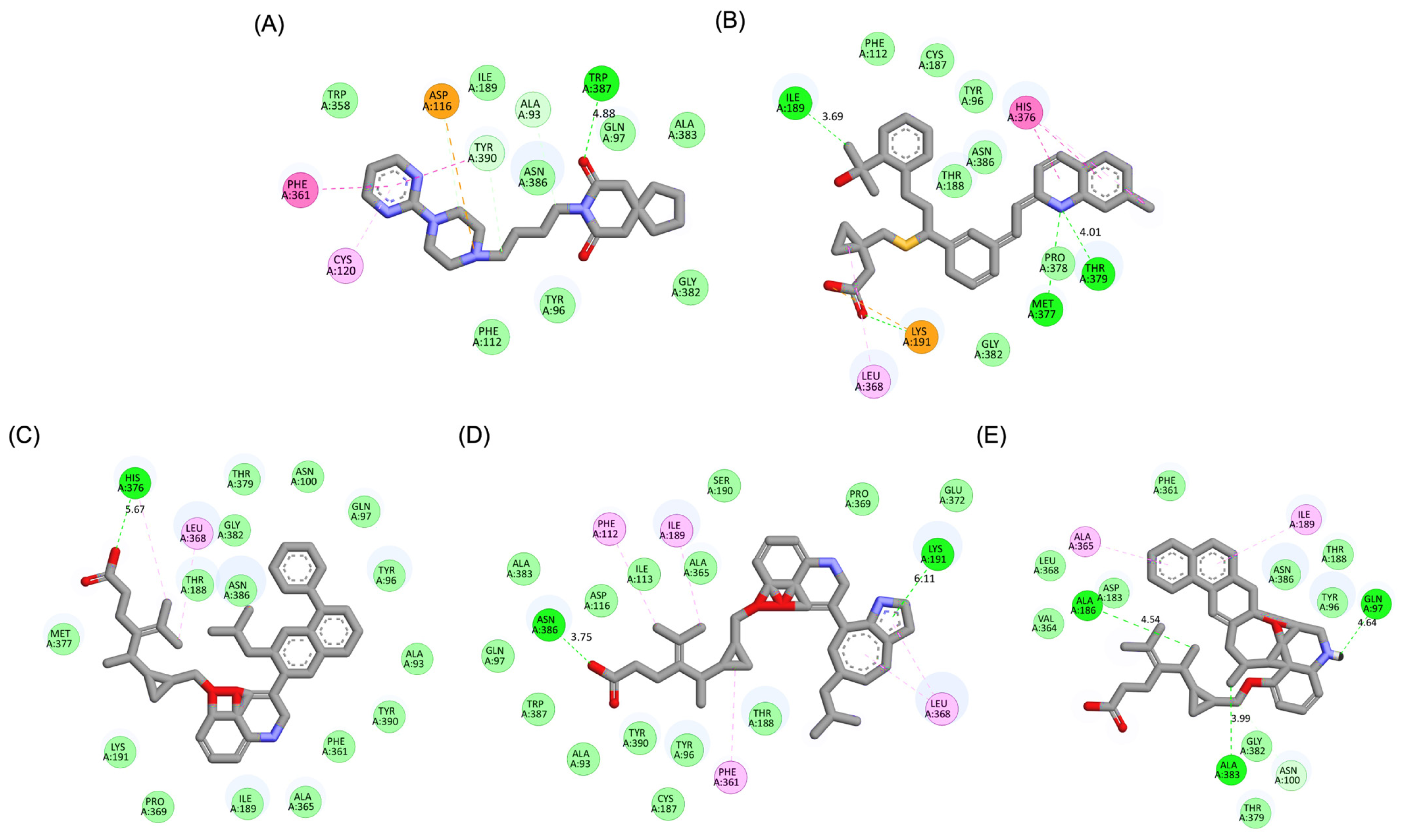

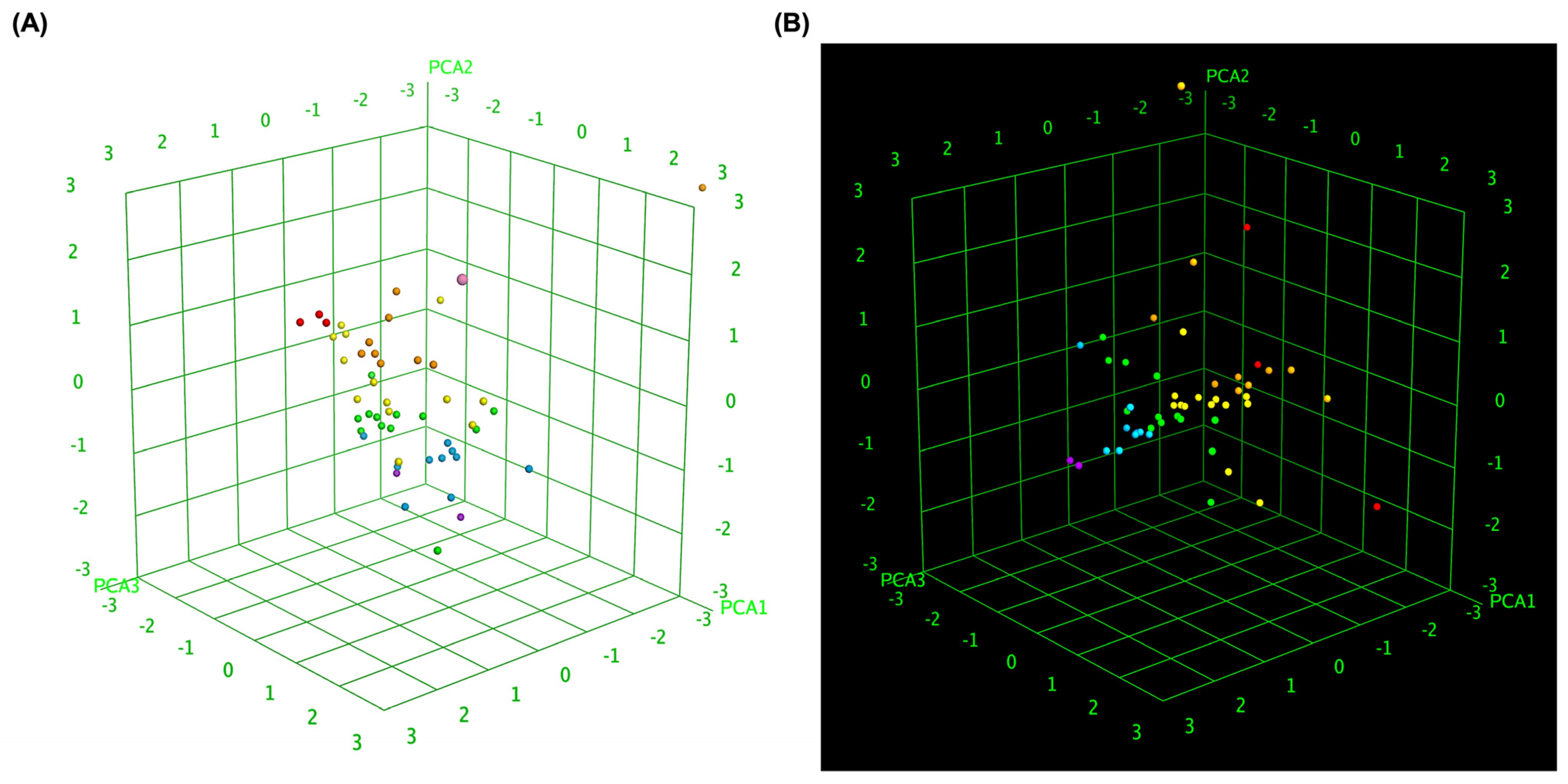


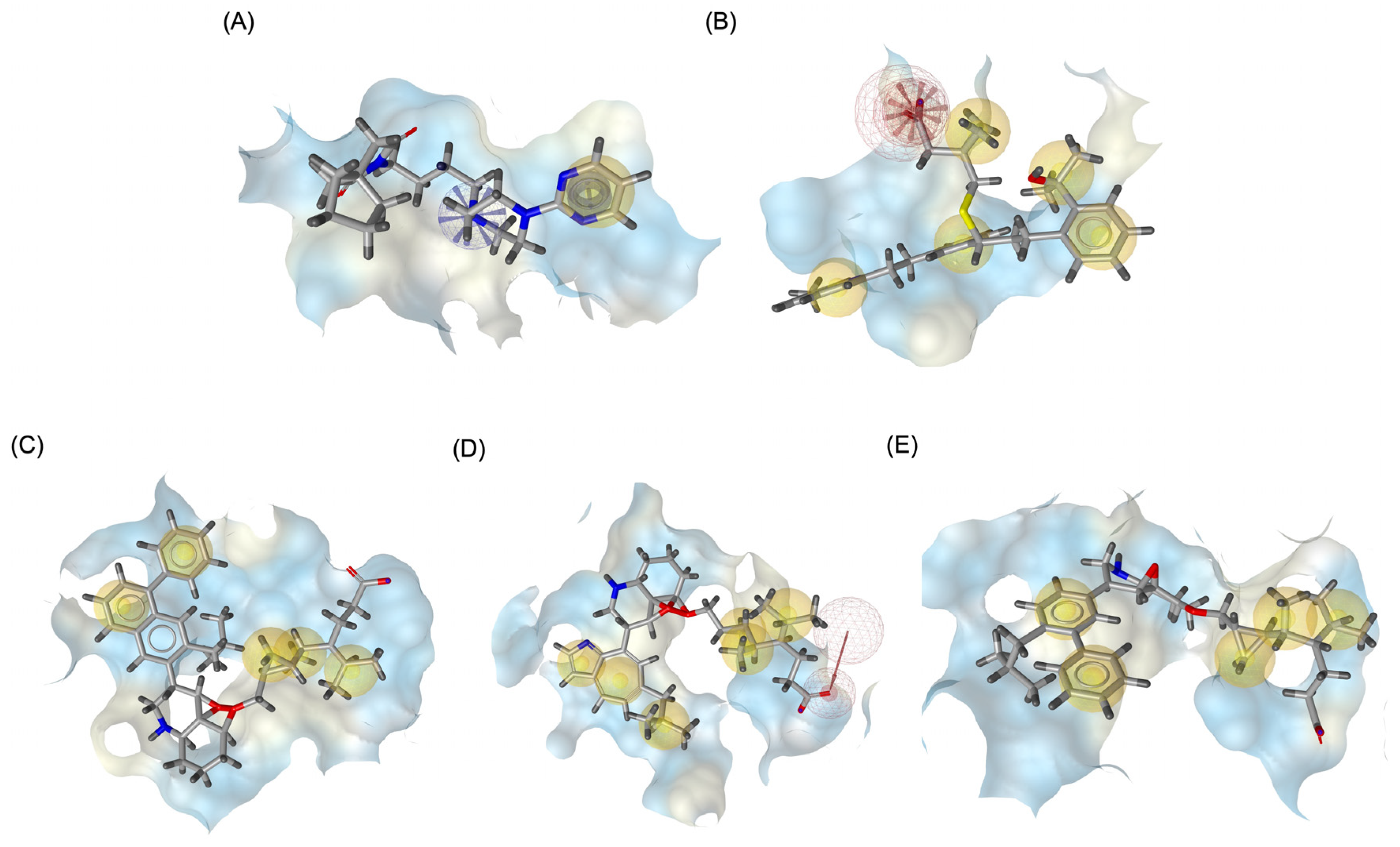
| Molecule | Modification Strategy | Modification | Purpose | 2D Structure |
|---|---|---|---|---|
| MONTELUKAST (MLK) | Baseline | N/A | N/A | 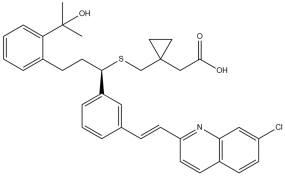 |
| MLK_MOD_1 | Aromatic Modification | Phenyl → Naphthyl | Increased π-π Stacking Interactions | 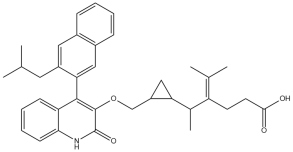 |
| MLK_MOD_6 | Heterocyclic Modification | Phenyl → Furan | Increased Polar Interactions |  |
| MLK_MOD_10 | Carboxyl Modification | Carboxyl → Amide | Improved Permeability | 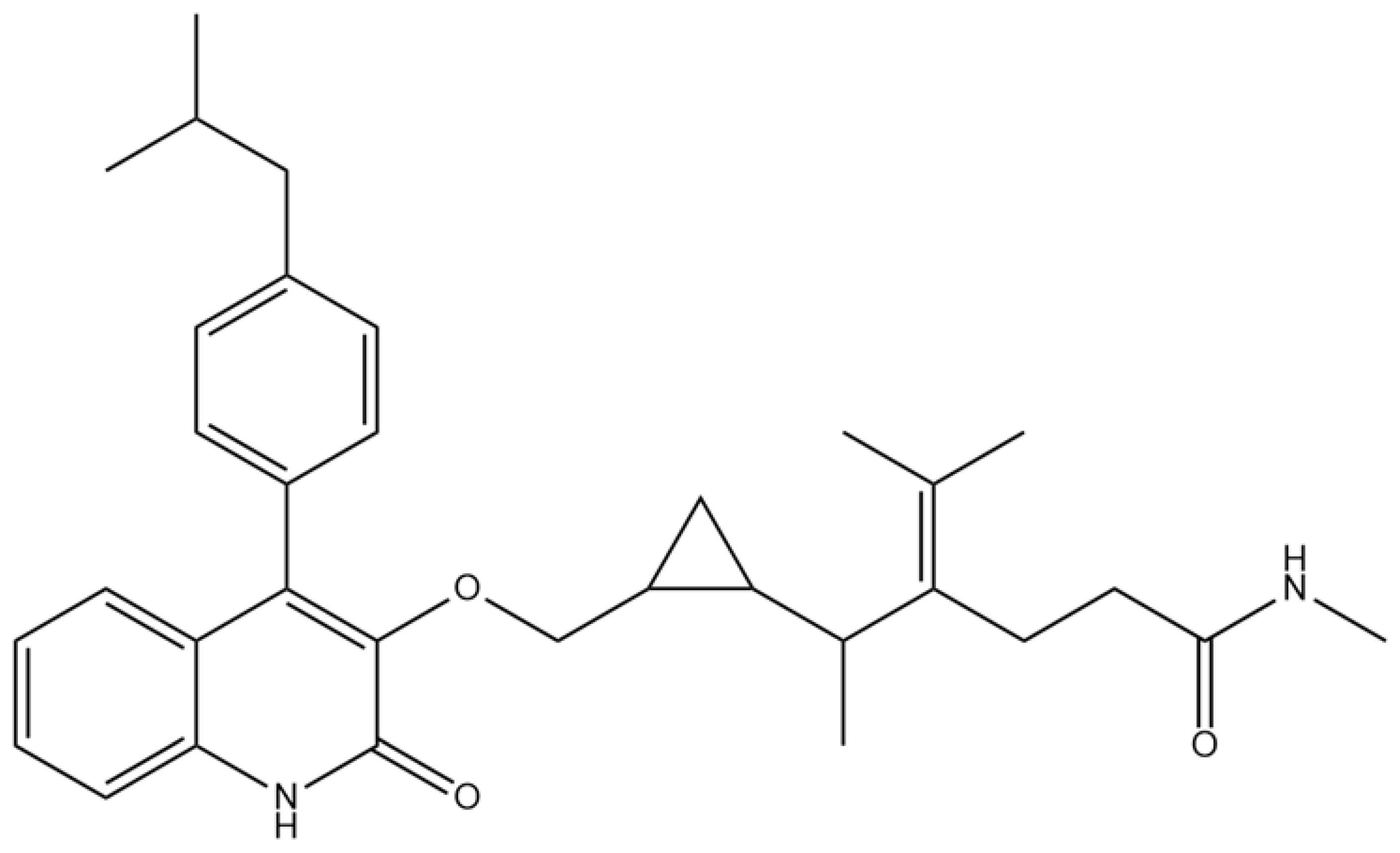 |
| MLK_MOD_11 | Carboxyl Modification | Carboxyl → Ester | Enhanced Lipophilicity |  |
| MLK_MOD_20 | Basic Side Chain | Guanidine Addition | Increased Hydrogen Bonding | 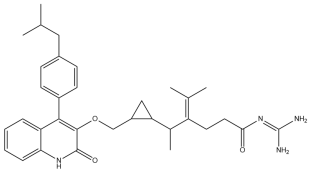 |
| MLK_MOD_22 | Heterocyclic Replacement | Phenyl → Quinoline | Improved Lipophilicity | 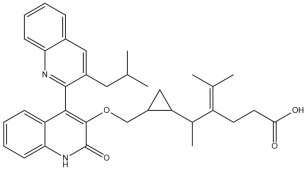 |
| MLK_MOD_35 | Basic Side Chain | Morpholine Addition | Improved Receptor Interactions |  |
| MLK_MOD_36 | Basic Side Chain | Imidazole Addition | Increased H-bonding | 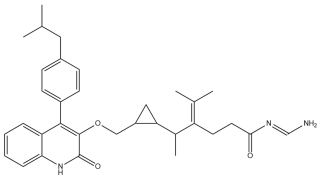 |
| MLK_MOD_42 | Fused Ring System | Phenyl → Fluorene | Increased Rigidity | 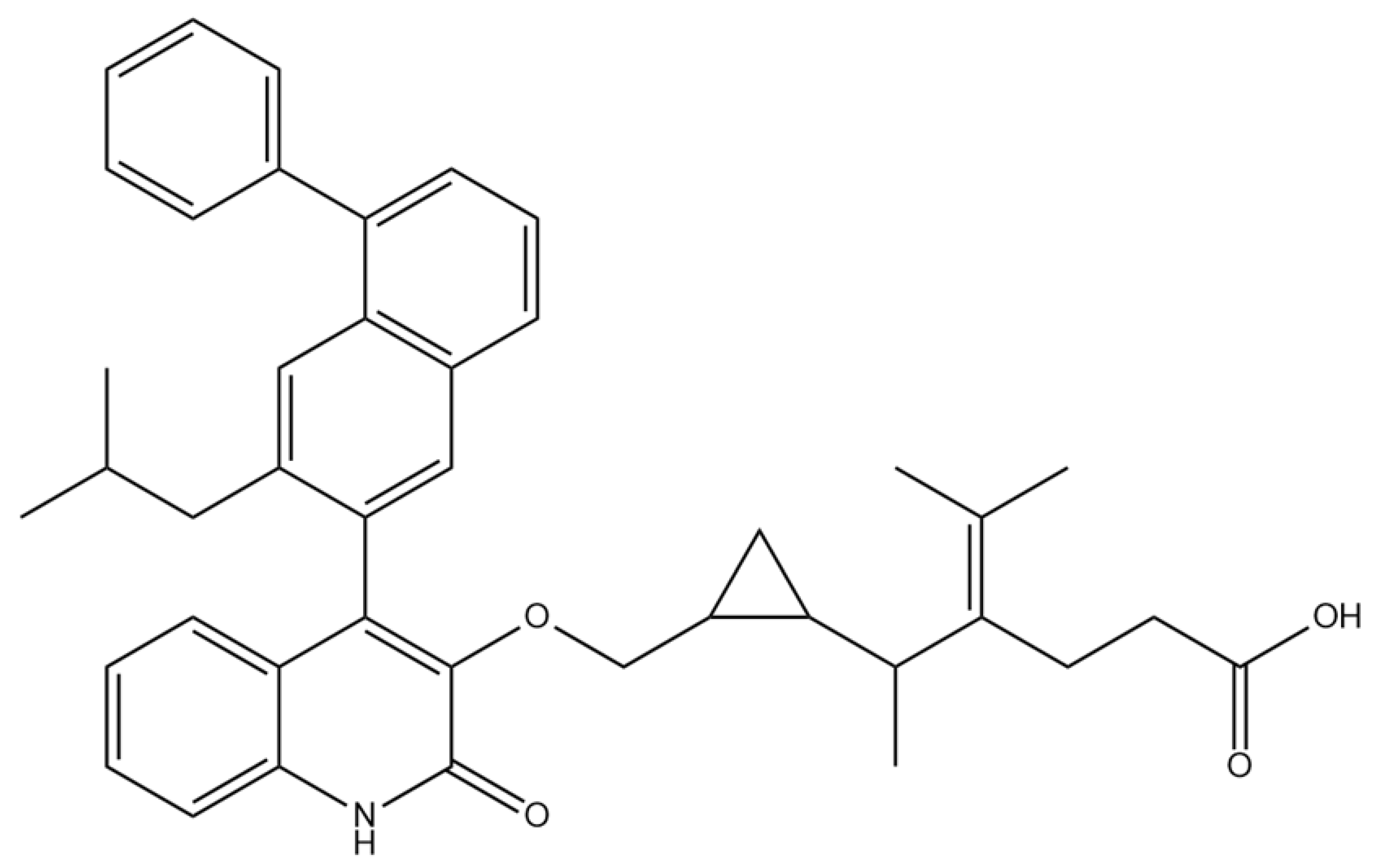 |
| MLK_MOD_43 | Fused Ring System | Phenyl → Carbazole | Increased Metabolic Stability |  |
| MLK_MOD_50 | Hybrid Scaffold | Chromene Extension | Increased Hydrophobicity |  |
| Complex | HADDOCK Score (a.u.) | Binding Energy (kcal/mol) | Van der Waals Energy | Electrostatic Energy | Desolvation Energy | RMSD |
|---|---|---|---|---|---|---|
| Haloperidol_DRD2 (Standard antagonist) | −41.0 ± 1.1 | −9.82 | −28.7 ± 0.8 | −58.8 ± 3.9 | −12.8 ± 0.4 | 0.2 ± 0.1 |
| MLK_DDR2 | −43.7 ± 4.7 | −8.26 | −36.1 ± 1.9 | −25.1 ± 1.0 | −11.7 ± 0.4 | 0.7 ± 0.0 |
| MLK_MOD-43_DRD2 | −46.0 ± 3.2 | −11.22 | −36.1 ± 2.2 | −125.0 ± 13.2 | −6.6 ± 0.9 | 0.3 ± 0.2 |
| MLK_MOD-27_DRD2 | −41.9 ± 0.7 | −10.61 | −33.7 ± 1.4 | 27.4 ± 13.2 | −16.0 ± 1.4 | 0.6 ± 0.0 |
| MLK_MOD-42_DRD2 | −45.3 ± 0.9 | −10.29 | −40.5 ± 2.2 | −25.8 ± 4.9 | −9.4 ± 0.7 | 0.8 ± 0.0 |
| MLK_MOD-22_DRD2 | −38.4 ± 1.7 | −10.11 | −28.4 ± 1.9 | −39.3 ± 10.9 | −10.9 ± 0.8 | 1.0 ± 0.0 |
| MLK_MOD-13_DRD2 | −38.0 ± 2.2 | −10.02 | −29.6 ± 1.4 | −61.9 ± 5.2 | −7.6 ± 0.2 | 0.6 ± 0.0 |
| MLK_MOD-33_DRD2 | −42.1 ± 1.1 | −9.97 | −33.8 ± 0.5 | 12.2 ± 9.7 | −13.2 ± 0.4 | 2.0 ± 0.0 |
| MLK_MOD-3_DRD2 | −38.3 ± 1.8 | −9.91 | −30.9 ± 0.8 | −57.8 ± 9.0 | −8.2 ± 0.2 | 0.7 ± 0.0 |
| MLK_MOD-15_DRD2 | −37.1 ± 2.5 | −9.85 | −31.0 ± 0.4 | −49.5 ± 10.9 | −7.3 ± 1.1 | 0.7 ± 0.0 |
| MLK_MOD-36_DRD2 | −37.9 ± 2.6 | −9.79 | −31.5 ± 1.8 | −32.2 ± 7.8 | −9.8 ± 0.3 | 0.8 ± 0.0 |
| MLK_MOD-4_DRD2 | −43.1 ± 2.5 | −9.76 | −35.1 ± 1.5 | 37.3 ± 6.3 | −14.6 ± 0.7 | 0.4 ± 0.1 |
| Complex | HADDOCK Score (a.u.) | Binding Energy (kcal/mol) | Van der Waals Energy | Electrostatic Energy | Desolvation Energy | RMSD |
|---|---|---|---|---|---|---|
| Buspirone_5-HT1A (Standard agonist) | −23.1 ± 0.8 | −8.3 | −34.3 ± 0.3 | −3.8 ± 2.4 | −13.2 ± 0.1 | 0.2 ± 0.2 |
| MLK_5-HT1A | −27.0 ± 1.3 | −9.71 | −28.7 ± 2.2 | −49.5 ± 10.1 | −11.8 ± 0.5 | 0.2 ± 0.2 |
| MLK_MOD-24_5-HT1A | −34.2 ± 2.8 | −11.04 | −31.2 ± 0.6 | −117.5 ± 6.1 | −10.6 ± 0.8 | 0.3 ± 0.2 |
| MLK_MOD-42_5-HT1A | −34.9 ± 1.6 | −10.97 | −38.2 ± 0.8 | −2.2 ± 20.7 | −17.4 ± 1.1 | 0.2 ± 0.1 |
| MLK_MOD-21_5-HT1A | −34.1 ± 1.7 | −10.76 | −33.8 ± 0.6 | −55.8 ± 0.3 | −12.5 ± 0.9 | 0.3 ± 0.2 |
| MLK_MOD-1_5-HT1A | −31.6 ± 0.6 | −10.74 | −31.1 ± 2.0 | −46.7 ± 6.4 | −14.3 ± 0.4 | 0.4 ± 0.2 |
| MLK_MOD-12_5-HT1A | −34.9 ± 2.3 | −10.64 | −30.9 ± 0.8 | −84.8 ± 7.3 | −9.4 ± 0.3 | 0.2 ± 0.2 |
| MLK_MOD-2_5-HT1A | −32.0 ± 1.7 | −10.45 | −32.5 ± 1.5 | −16.9 ± 3.5 | −12.4 ± 0.3 | 0.4 ± 0.2 |
| MLK_MOD-16_5-HT1A | −31.8 ± 1.0 | −10.44 | −31.5 ± 0.8 | −22.6 ± 0.6 | −12.7 ± 0.2 | 0.2 ± 0.1 |
| MLK_MOD-38_5-HT1A | −32.3 ± 0.7 | −10.43 | −33.3 ± 1.1 | −37.9 ± 5.4 | −14.2 ± 1.1 | 0.4 ± 0.2 |
| MLK_MOD-43_5-HT1A | −31.3 ± 1.6 | −10.42 | −30.2 ± 1.4 | −21.1 ± 0.5 | −11.2 ± 0.1 | 0.1 ± 0.0 |
| MLK_MOD-41_5-HT1A | −30.4 ± 1.0 | −10.40 | −31.3 ± 0.7 | −13.5 ± 3.6 | −12.1 ± 0.9 | 0.6 ± 0.0 |
| Complex | CC | CO | CN | CX | OO | OX | NO | NN | NX | XX |
|---|---|---|---|---|---|---|---|---|---|---|
| Haloperidol_DRD2 (Standard antagonist) | 2782 | 945 | 700 | 173 | 61 | 42 | 79 | 25 | 38 | 1 |
| MLK_DDR2 | 1985 | 751 | 624 | 70 | 59 | 20 | 72 | 13 | 22 | 0 |
| MLK_MOD-43_DRD2 | 3193 | 1393 | 1118 | 22 | 100 | 2 | 123 | 25 | 0 | 0 |
| MLK_MOD-27_DRD2 | 3813 | 1400 | 1074 | 315 | 105 | 77 | 159 | 48 | 74 | 4 |
| MLK_MOD-42_DRD2 | 3427 | 1349 | 1071 | 3 | 101 | 2 | 103 | 24 | 2 | 0 |
| MLK_MOD-22_DRD2 | 3183 | 1299 | 881 | 17 | 115 | 5 | 135 | 37 | 0 | 0 |
| MLK_MOD-13_DRD2 | 2796 | 1124 | 865 | 138 | 93 | 32 | 102 | 28 | 27 | 1 |
| Buspirone_5-HT1A (Standard agonist) | 2650 | 888 | 1268 | 42 | 63 | 2 | 217 | 141 | 10 | 0 |
| MLK_5-HT1A | 2636 | 1001 | 730 | 127 | 81 | 34 | 77 | 12 | 19 | 2 |
| MLK_MOD-24_5-HT1A | 3298 | 1293 | 1017 | 57 | 109 | 6 | 154 | 53 | 3 | 0 |
| MLK_MOD-42_5-HT1A | 4104 | 1407 | 1090 | 63 | 84 | 3 | 96 | 22 | 2 | 0 |
| MLK_MOD-21_5-HT1A | 3558 | 1471 | 1028 | 66 | 117 | 5 | 159 | 48 | 3 | 0 |
| MLK_MOD-1_5-HT1A | 3568 | 1345 | 953 | 71 | 113 | 2 | 115 | 22 | 2 | 0 |
| MLK_MOD-43_5-HT1A | 3524 | 1252 | 946 | 50 | 76 | 5 | 98 | 28 | 1 | 0 |
| Complex | Average RMSD (Å) | Average RMSF (Å) | Average RoG (Å) | Number of Hydrogen Bonds Between the Ligand and Receptor |
|---|---|---|---|---|
| DRD2 (Apo-protein) | 1.806 | 0.662 | 2.105 | N/A |
| Haloperidol_DRD2 (Standard antagonist) | 2.776 | 1.708 | 2.643 | 2 |
| MLK_DDR2 | 2.635 | 1.375 | 2.554 | 0 |
| MLK_MOD-43_DRD2 | 2.441 | 1.954 | 2.831 | 3 |
| MLK_MOD-27_DRD2 | 2.674 | 1.743 | 2.789 | 2 |
| MLK_MOD-42_DRD2 | 2.145 | 1.811 | 2.815 | 5 |
| MLK_MOD-22_DRD2 | 2.262 | 1.429 | 2.524 | 2 |
| MLK_MOD-13_DRD2 | 2.517 | 1.465 | 2.483 | 4 |
| 5-HT1A (Apo-protein) | 2.011 | 1.012 | 2.345 | N/A |
| Buspirone_5-HT1A (Standard agonist) | 2.487 | 1.440 | 2.712 | 1 |
| MLK_5-HT1A | 2.234 | 1.488 | 2.862 | 4 |
| MLK_MOD-24_5-HT1A | 2.331 | 1.299 | 2.847 | 3 |
| MLK_MOD-42_5-HT1A | 2.189 | 1.129 | 2.803 | 2 |
| MLK_MOD-21_5-HT1A | 2.446 | 1.315 | 2.818 | 1 |
| MLK_MOD-1_5-HT1A | 2.284 | 1.421 | 2.805 | 3 |
| MLK_MOD-43_5-HT1A | 2.221 | 1.319 | 2.916 | 2 |
| Complex | MM/PBSA Free Binding Energy ΔG_binding (kcal/mol) |
|---|---|
| Haloperidol_DRD2 (standard antagonist) | −23.41 ± 3.24 |
| MLK_DDR2 | −19.32 ± 4.18 |
| MLK_MOD-43_DRD2 | −27.37 ± 2.22 |
| MLK_MOD-27_DRD2 | −25.65 ± 3.01 |
| MLK_MOD-42_DRD2 | −31.92 ± 2.54 |
| MLK_MOD-22_DRD2 | −26.81 ± 3.32 |
| MLK_MOD-13_DRD2 | −24.15 ± 2.38 |
| Buspirone_5-HT1A (standard agonist) | −27.92 ± 1.34 |
| MLK_5-HT1A | −20.14 ± 3.67 |
| MLK_MOD-24_5-HT1A | −24.90 ± 2.33 |
| MLK_MOD-42_5-HT1A | −30.22 ± 2.29 |
| MLK_MOD-21_5-HT1A | −27.87 ± 3.38 |
| MLK_MOD-1_5-HT1A | −22.82 ± 2.29 |
| MLK_MOD-43_5-HT1A | −28.19 ± 2.14 |
| Molecule | MW (g/mol) | MlogP | HBA | HBD | TPSA (Å2) | Lipinski Violation | CYP Inhibitor |
|---|---|---|---|---|---|---|---|
| Montelukast (MLK) | 586.18 | 5.70 | 4 | 2 | 95.72 | 2 violations: MW > 500, MLOGP > 4.15 | CYP2C19, CYP2D6, CYP3A4 |
| MLK_MOD-1 | 551.72 | 5.65 | 4 | 2 | 79.39 | 2 violations: MW > 500, MLOGP > 4.15 | CYP2C19, CYP2D6, CYP3A4 |
| MLK_MOD-6 | 491.62 | 3.94 | 5 | 2 | 92.53 | 0 | CYP2C19, CYP2C9, CYP2D6, CYP3A4 |
| MLK_MOD-12 | 517.66 | 4.55 | 5 | 3 | 99.62 | 2 violations: MW > 500, MLOGP > 4.15 | CYP2C19, CYP2C9, CYP2D6, CYP3A4 |
| MLK_MOD-13 | 519.65 | 5.46 | 5 | 2 | 79.39 | 2 violations: MW > 500, MLOGP > 4.15 | CYP2C19, CYP2C9, CYP2D6, CYP3A4 |
| MLK_MOD-21 | 552.70 | 4.69 | 5 | 2 | 92.28 | 2 violations: MW > 500, MLOGP > 4.15 | CYP2C19, CYP2C9, CYP2D6, CYP3A4 |
| MLK_MOD-22 | 552.70 | 4.93 | 5 | 2 | 92.28 | 2 violations: MW > 500, MLOGP > 4.15 | CYP2C19, CYP2C9, CYP2D6, CYP3A4 |
| MLK_MOD-35 | 570.76 | 4.61 | 4 | 1 | 71.63 | 2 violations: MW > 500, MLOGP > 4.15 | CYP2C19, CYP2D6, CYP3A4 |
| MLK_MOD-36 | 527.70 | 5.21 | 4 | 2 | 97.54 | 2 violations: MW > 500, MLOGP > 4.15 | CYP2C19, CYP2C9, CYP2D6, CYP3A4 |
| MLK_MOD-42 | 627.81 | 6.49 | 4 | 2 | 79.39 | 2 violations: MW > 500, MLOGP > 4.15 | CYP2D6 |
| MLK_MOD-43 | 601.77 | 6.18 | 4 | 2 | 79.39 | 2 violations: MW > 500, MLOGP > 4.15 | CYP2D6 |
| Molecule | Drug-Likeness | Mutagenic | Tumorigenic | Reproductive Effective | Irritant |
|---|---|---|---|---|---|
| MLK_MOD-1 | 1.433 | None | None | High | None |
| MLK_MOD-6 | 2.669 | High | None | None | None |
| MLK_MOD-12 | 1.433 | None | None | High | None |
| MLK_MOD-13 | 0.093 | None | None | High | None |
| MLK_MOD-21 | 2.031 | None | None | None | None |
| MLK_MOD-22 | 1.433 | None | None | None | None |
| MLK_MOD-35 | 3.371 | None | None | High | High |
| MLK_MOD-36 | 1.504 | None | None | High | None |
| MLK_MOD-42 | 4.862 | None | None | High | None |
| MLK_MOD-43 | 1.433 | None | None | High | None |
Disclaimer/Publisher’s Note: The statements, opinions and data contained in all publications are solely those of the individual author(s) and contributor(s) and not of MDPI and/or the editor(s). MDPI and/or the editor(s) disclaim responsibility for any injury to people or property resulting from any ideas, methods, instructions or products referred to in the content. |
© 2025 by the authors. Licensee MDPI, Basel, Switzerland. This article is an open access article distributed under the terms and conditions of the Creative Commons Attribution (CC BY) license (https://creativecommons.org/licenses/by/4.0/).
Share and Cite
Alotaiq, N.; Dermawan, D. Computational Investigation of Montelukast and Its Structural Derivatives for Binding Affinity to Dopaminergic and Serotonergic Receptors: Insights from a Comprehensive Molecular Simulation. Pharmaceuticals 2025, 18, 559. https://doi.org/10.3390/ph18040559
Alotaiq N, Dermawan D. Computational Investigation of Montelukast and Its Structural Derivatives for Binding Affinity to Dopaminergic and Serotonergic Receptors: Insights from a Comprehensive Molecular Simulation. Pharmaceuticals. 2025; 18(4):559. https://doi.org/10.3390/ph18040559
Chicago/Turabian StyleAlotaiq, Nasser, and Doni Dermawan. 2025. "Computational Investigation of Montelukast and Its Structural Derivatives for Binding Affinity to Dopaminergic and Serotonergic Receptors: Insights from a Comprehensive Molecular Simulation" Pharmaceuticals 18, no. 4: 559. https://doi.org/10.3390/ph18040559
APA StyleAlotaiq, N., & Dermawan, D. (2025). Computational Investigation of Montelukast and Its Structural Derivatives for Binding Affinity to Dopaminergic and Serotonergic Receptors: Insights from a Comprehensive Molecular Simulation. Pharmaceuticals, 18(4), 559. https://doi.org/10.3390/ph18040559







